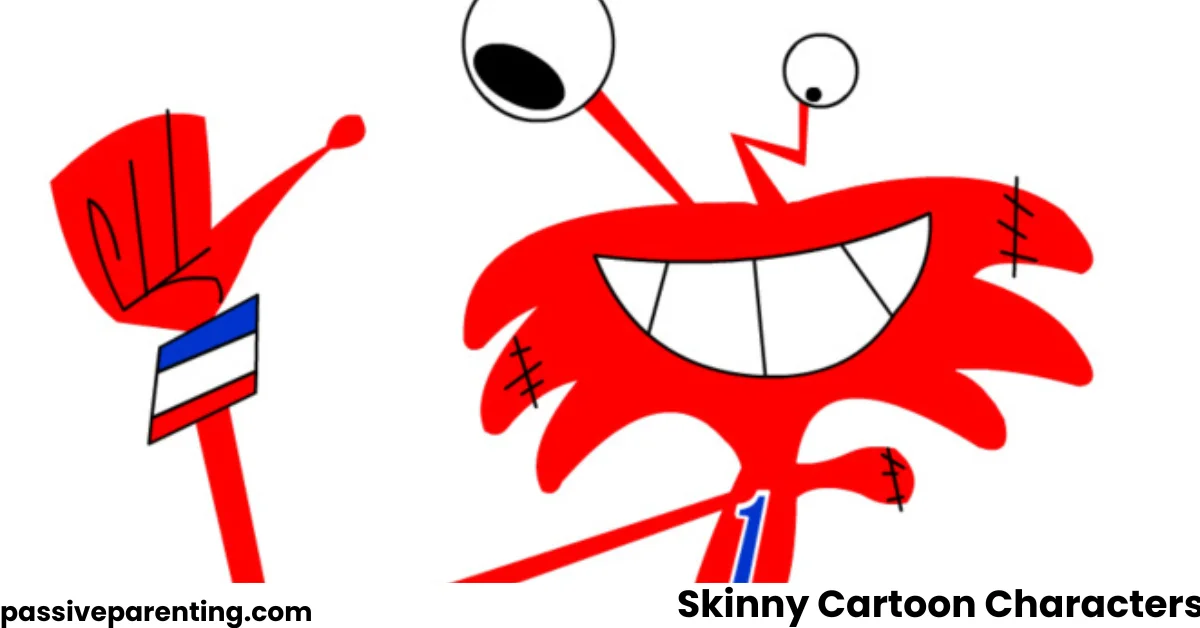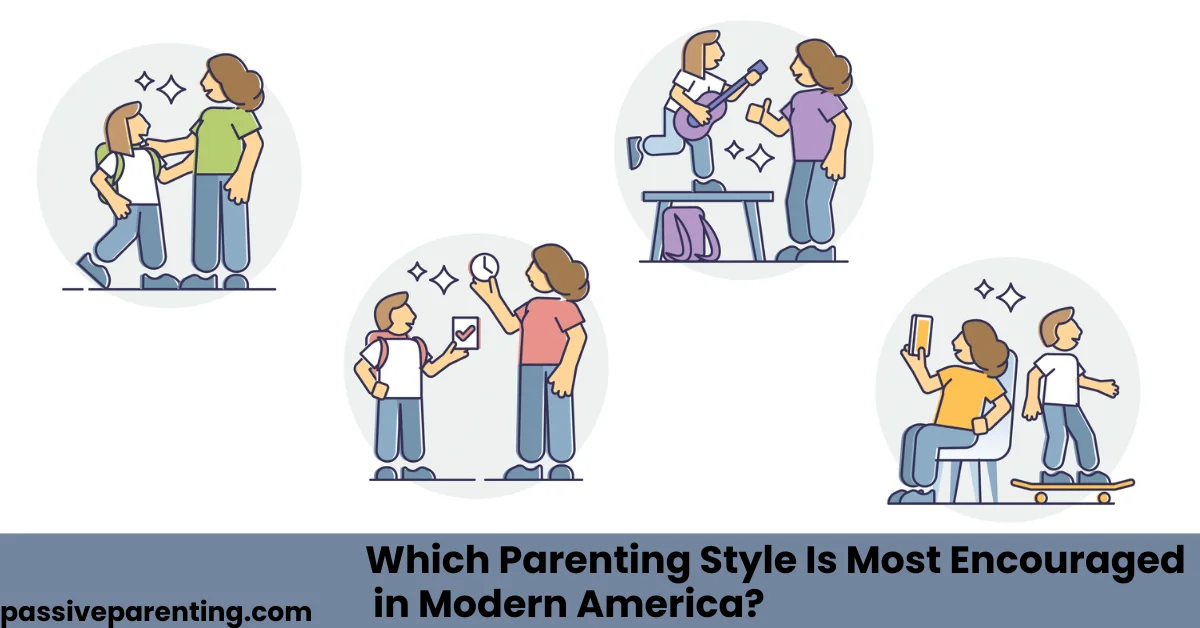From classic Saturday morning shows to modern animated hits, skinny cartoon characters have become some of the most memorable figures in pop culture. Whether it’s the lanky awkwardness of Shaggy from Scooby-Doo, the skeletal elegance of Jack Skellington, or the exaggerated genius of Dr. Doofenshmirtz, thin-bodied characters carry visual energy and personality that make them unforgettable.
But what makes animators and designers choose such slim silhouettes? Why do audiences find them funny, relatable, or even endearing? In this article, we’ll explore the artistry behind skinny cartoon characters, their symbolic meanings, and the role they play in defining animation style and storytelling.
The Purpose Behind Skinny Cartoon Characters
Animation exaggerates reality and that’s what makes it powerful. Skinny cartoon characters aren’t just drawn thin for aesthetics; their design communicates traits instantly. According to Animation Mentor, shape language plays a huge role in how audiences perceive a character:
- Round shapes suggest friendliness and softness.
- Square shapes imply strength and stability.
- Thin or triangular shapes signal speed, intelligence, or mischief.
That’s why characters like Shaggy Rogers or Olive Oyl look tall and wiry, their form visually matches their quirky or nervous energy. The exaggerated thinness emphasizes movement and adds humor, especially in slapstick animation.
Early Examples of Skinny Cartoon Characters
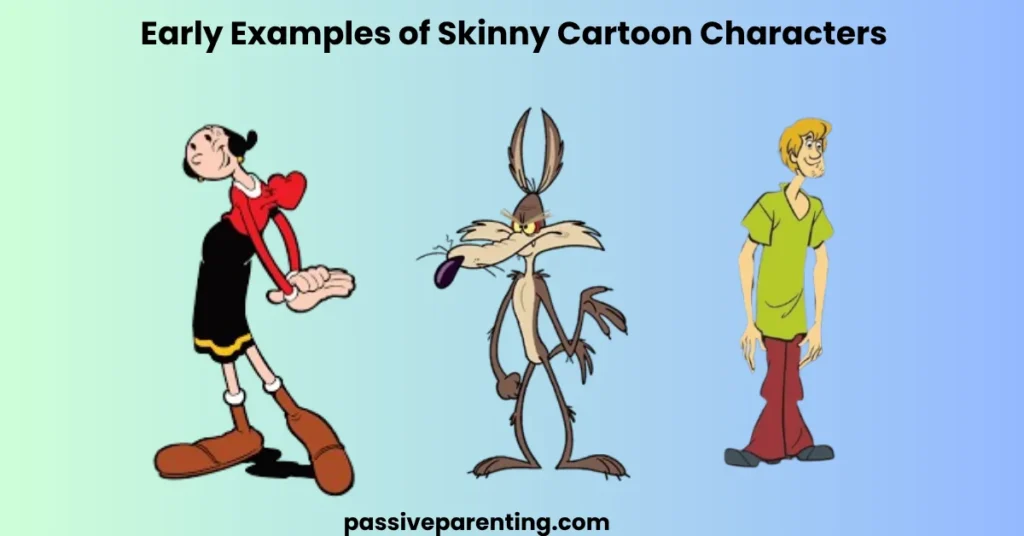
Olive Oyl – Popeye the Sailor
Olive Oyl, one of the earliest skinny cartoon icons, first appeared in 1919 and remains instantly recognizable. Her long neck, spindly limbs, and tiny feet weren’t meant to mock, they accentuated her fragile, expressive movements. Her body exaggerated femininity and frailty in contrast to Popeye’s stocky strength, creating comic balance on screen.
Wile E. Coyote – Looney Tunes
Wile E. Coyote’s long, narrow frame made him the perfect visual opposite to the compact Road Runner. His thin build enhances every tumble, crash, and explosion. According to Cartoon Brew, animators deliberately kept his design lean to amplify the elasticity and slapstick exaggeration crucial to Warner Bros.’ comedic timing.
Shaggy Rogers – Scooby-Doo
Since his debut in 1969, Shaggy has personified nervous energy, a gangly teen always one step from panic. His tall, skinny form complements his personality: lazy, clumsy, and perpetually hungry. The design emphasizes his lack of athleticism and contrasts against Velma’s compact or Fred’s muscular build.
Modern Skinny Cartoon Characters
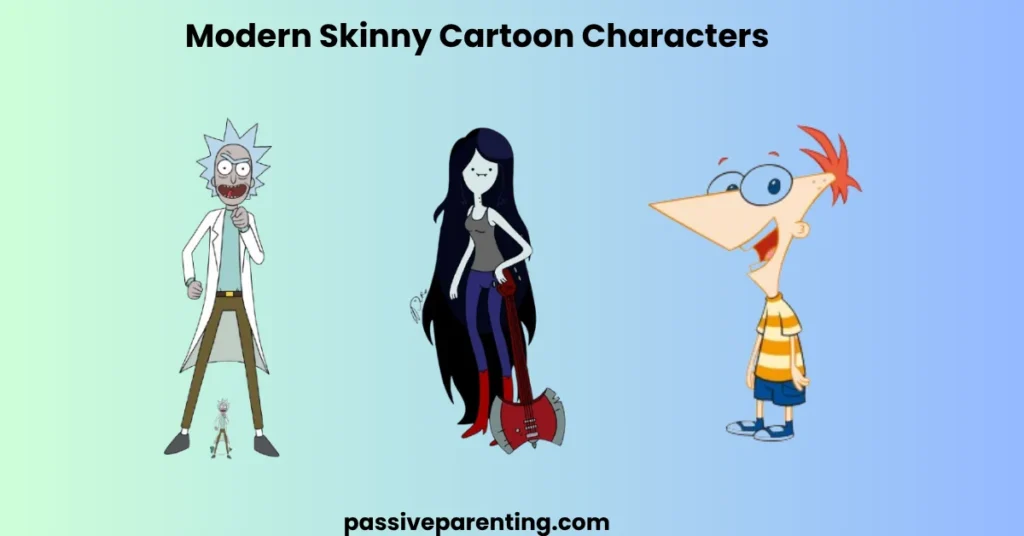
Rick Sanchez – Rick and Morty
Rick’s spindly body matches his chaotic brilliance. The exaggerated thinness and awkward posture mirror his erratic behavior and lack of care for appearances. According to Animation World Network (AWN), Rick’s visual design intentionally defies heroic proportions, emphasizing intellect over strength.
Marceline – Adventure Time
Marceline’s lean figure, long hair, and effortless posture reflect her identity as a cool, laid-back vampire musician. She’s proof that a “skinny” cartoon character doesn’t need to be goofy, slim silhouettes can also express style, rebellion, and emotional complexity.
Phineas Flynn – Phineas and Ferb
Phineas’s body is built around geometric exaggeration, a triangle for a head, thin limbs for quick movement. His slim design symbolizes boundless curiosity and creativity. His energy isn’t physical power but imaginative force.
Skinny Cartoon Villains: The Power of Sharp Lines
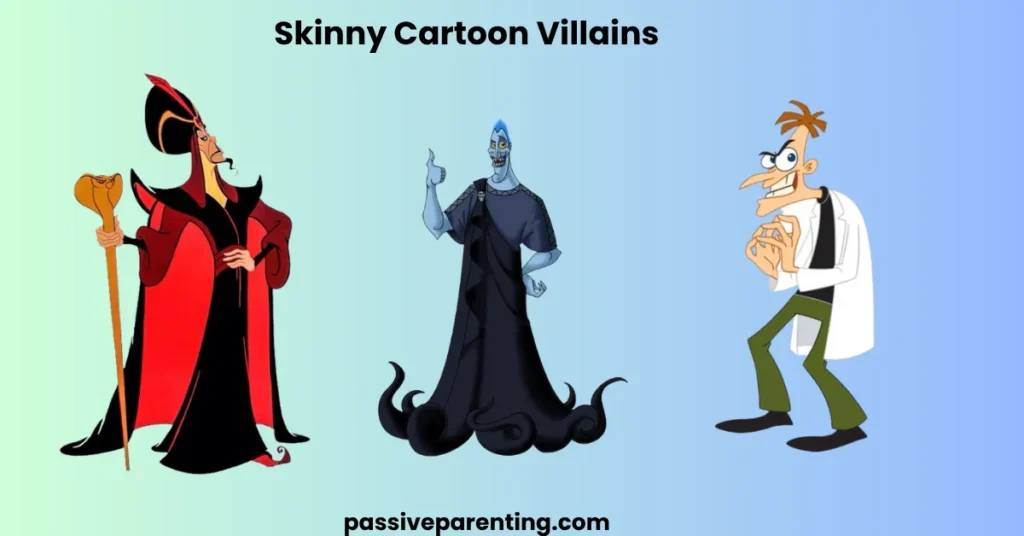
Thin characters often make for great villains. Sharp, elongated features visually imply cunning, speed, or danger. In animation psychology, angular shapes trigger subconscious feelings of unease, a technique used since Disney’s golden age.
Jafar – Aladdin
Jafar’s tall, skeletal frame and sharp angles echo his sinister nature. His body moves with snake-like precision, symbolizing manipulation. The Atlantic notes that animators use these forms to signal elegance mixed with menace, a visual shorthand for deceit.
Hades – Hercules
Hades’ lanky silhouette, animated with fire-like gestures, gives him a flamboyant charm despite his villainy. The thinness makes him seem agile and unpredictable, a design contrast to Hercules’s broad, solid build.
Dr. Doofenshmirtz – Phineas and Ferb
Doofenshmirtz’s awkwardly thin frame reinforces his comedic failure. Despite his “evil genius” label, his posture and frailness underline his clumsiness and humanity. He’s more sympathetic than scary, proof that thinness can express humor as much as threat.
Funny and Lovable Skinny Cartoon Characters
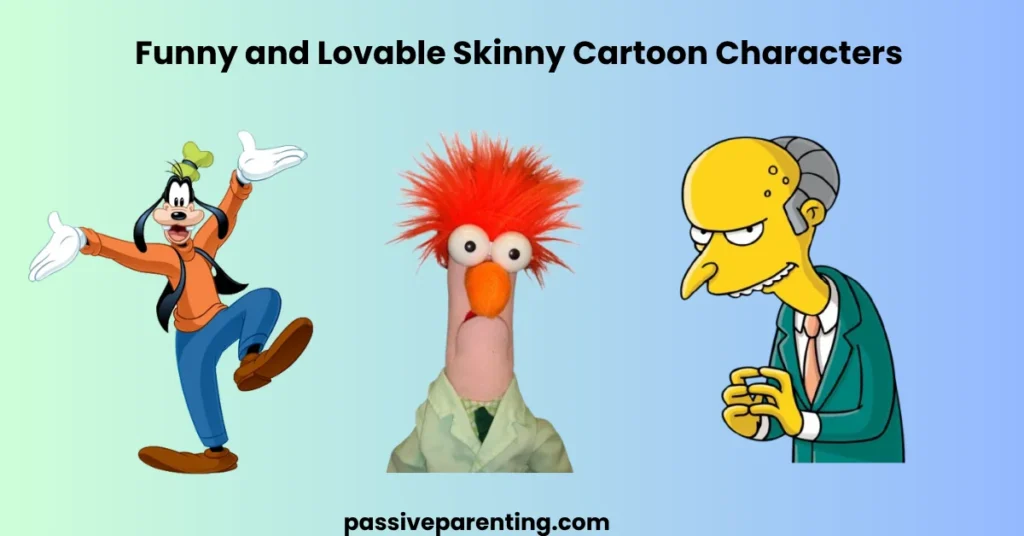
Not all skinny characters are villains, some are pure comedy gold.
Goofy – Disney
Goofy’s long limbs and floppy movements are central to his humor. His body stretches, bends, and twists in ways that defy physics, making him endlessly entertaining. Disney animators designed him to be “rubberlike,” emphasizing warmth despite awkwardness.
Beaker – The Muppets
Beaker’s thin, tube-shaped body and constantly trembling motions exaggerate nervousness. He’s the perfect slapstick assistant, a visual metaphor for fragility in a chaotic world.
Mr. Burns – The Simpsons
Charles Montgomery Burns embodies greed and frailty. His thin, hunched posture underscores both age and villainy. His body communicates weakness, but his scheming brain gives him power, a deliberate irony that defines The Simpsons’ satire.
Female Skinny Cartoon Characters Through the Ages
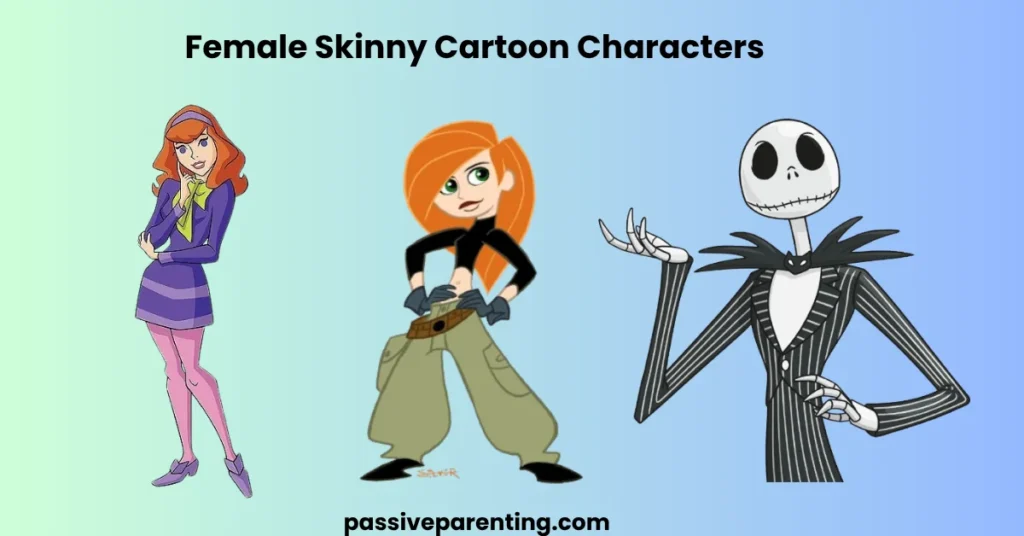
Daphne Blake – Scooby-Doo
Daphne’s tall, slim frame became the blueprint for stylish animated heroines in the late 20th century. While her looks were exaggerated, Screen Rant notes that later reboots gave her depth and agency, showing that even stylized figures can evolve beyond appearance.
Kim Possible – Kim Possible
Kim Possible’s athletic yet slim body reflects confidence and energy, not fragility. Her design shows how thin characters can project agility and competence rather than weakness.
Jack Skellington – The Nightmare Before Christmas
While technically male, Jack’s tall, skeletal figure carries an elegance more akin to ballet than horror. Tim Burton’s signature style turns thinness into beauty, an otherworldly grace that captivates rather than frightens.
Artistic Psychology: Why Thin Works So Well
According to Character Design Quarterly and Pixar’s Design Language, thin characters visually communicate movement and contrast. The principles of “shape language” explain how our brains process character traits from silhouettes alone.
- Thin lines and elongated limbs = agility, intellect, or nervousness.
- Curved, rounded shapes = warmth and friendliness.
- Jagged or angular forms = tension, danger, or arrogance.
Skinny characters often dominate motion-based humor, since their flexible forms allow extreme poses and timing. Think of Shaggy’s frantic running, Goofy’s tumbles, or Wile E. Coyote’s stretched midair falls, all iconic moments made possible by the expressiveness of slim design.
Modern Representation and Body Diversity in Animation
While thin characters have long dominated animation, modern creators are broadening representation. Studios like Pixar and DreamWorks now design casts with more varied body shapes to reflect real-world diversity.
The Atlantic and Animation World Network note that while exaggerated body types remain a storytelling tool, creators are becoming more mindful about the messages they send. The goal is balance, embracing stylization while avoiding stereotypes.
Recent characters such as Luz Noceda (The Owl House) and Encanto’s family ensemble show that animation is shifting toward more inclusive proportions while maintaining expressiveness.
The Symbolism Behind Skinny Cartoon Characters
Skinny cartoon characters often symbolize more than humor, they represent curiosity, fragility, wit, or eccentricity. In design language, thinness can communicate:
- Intelligence or precision (Rick Sanchez, Jafar)
- Goofiness or nervousness (Shaggy, Beaker)
- Elegance or creativity (Jack Skellington, Marceline)
- Ambition or overreach (Mr. Burns, Dr. Doofenshmirtz)
By exaggerating thinness, animators amplify these inner traits. It’s never about physicality, it’s about personality drawn large.
Notable Skinny Cartoon Characters (Quick Reference)
- Shaggy Rogers (Scooby-Doo) – The lovable coward.
- Olive Oyl (Popeye) – The original long-limbed heroine.
- Jack Skellington (The Nightmare Before Christmas) – The elegant skeleton.
- Dr. Doofenshmirtz (Phineas and Ferb) – The awkward villain genius.
- Wile E. Coyote (Looney Tunes) – The eternal optimist in failure.
- Marceline (Adventure Time) – The effortlessly cool vampire.
- Mr. Burns (The Simpsons) – Frail but fearsome capitalist.
- Goofy (Disney) – The ultimate lanky slapstick hero.
- Rick Sanchez (Rick and Morty) – The intellectual rebel.
- Jafar (Aladdin) – The serpentine schemer.
How Skinny Character Design Influences Storytelling
In animation, form follows function. A character’s body shape is an extension of their narrative role.
- Thin = fast, nervous, flexible.
- Thick = strong, steady, dependable.
- Round = friendly, warm, harmless.
By contrasting these body types, directors create visual rhythm. A team of differently shaped characters like in Scooby-Doo or The Incredibles, feels dynamic because each silhouette brings a unique energy to the frame.
According to Pixar’s Storytelling Framework, diversity in shapes helps maintain visual interest and emotional clarity.
What Artists Can Learn from Skinny Cartoon Characters
For animators or illustrators, designing skinny characters offers creative freedom:
- Play with exaggeration. Stretch limbs, elongate necks, or tilt posture to imply motion.
- Focus on silhouette clarity. The shape should communicate personality even in shadow.
- Balance proportions. Make sure exaggerated thinness doesn’t hinder expressiveness.
- Use motion arcs. Skinny characters work best when animated with fluid, sweeping gestures.
As Animation Mentor explains, “Clarity of shape is clarity of story.” That’s why many thin designs remain timeless, they’re simple, readable, and emotionally honest.
The Lasting Appeal of Skinny Cartoon Characters
Despite evolving animation styles, skinny cartoon characters endure because they connect movement, personality, and humor in one elegant package. Their long limbs and wiry frames give them unmatched flexibility, both physically and symbolically.
From the nostalgic 2D heroes of classic TV to today’s edgy, expressive animation, these characters continue to prove that skinny doesn’t mean weak, it means dynamic.
Their design captures the essence of animation itself: exaggerated, emotional, and infinitely expressive.
Final Thoughts
Skinny cartoon characters aren’t just a visual trope, they’re a storytelling language. Their slender silhouettes allow animators to explore humor, fragility, and grace in ways rounder characters can’t. As animation continues to evolve, these designs remind us that body shape isn’t about realism, it’s about expression.
Whether it’s Shaggy’s nervous laughter or Jack Skellington’s poetic stride, these characters prove that being “skinny” in animation is less about size and more about spirit.

